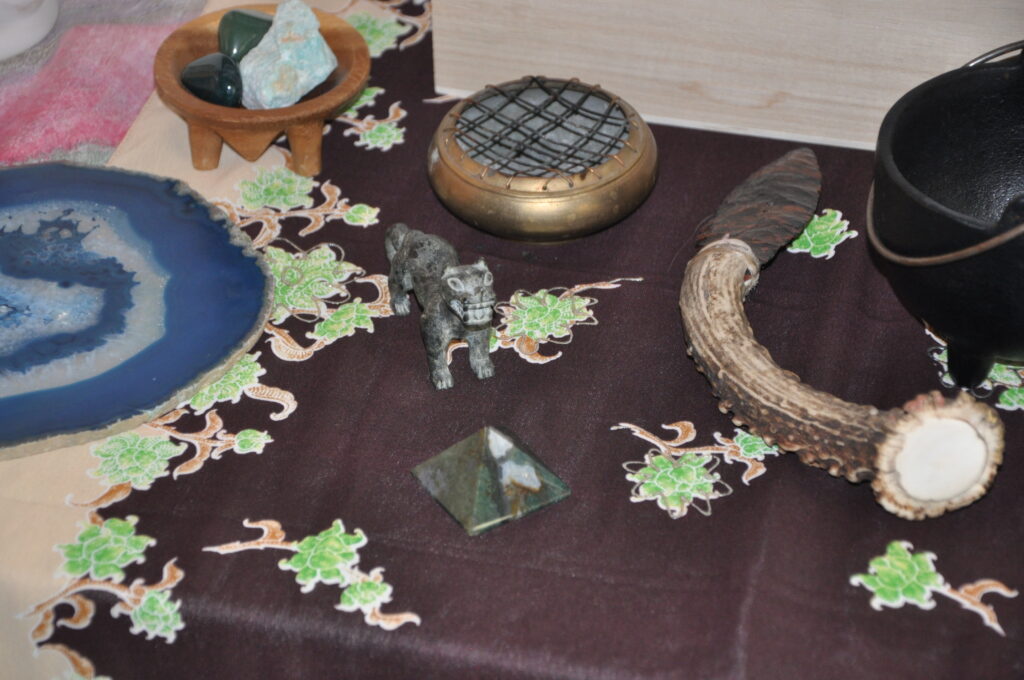I grew up in a house full of altars. My nominally Catholic mother would probably dispute my calling them that, but every flat surface in the house had a grouping of objects that were special. Candles in unusual holders sat next to the flowering violets and small portraits of family members in the hall. Pottery forms shared space with crystals and shells in the living room. Every once in a while my mother would rearrange the furniture and the altars would be changed, moved, reformed into new combinations. Through this environmental exposure I learned to see altars as an integral part of one’s life. A place for the sacred to be with you in personal, tangible ways.

Sacred space can be found in the tiny inhaled of one’s breath as much as in the largest cathedral. When we create sacred space, we make ourselves spiritually receptive to the sacred, as well as giving ourselves a specific place to pray, meditate, or perform rituals. Creating an altar gives you a place to find what connects your heart to the larger heart of the Universe.
Our modern practice of creating an altar in the home has ancient roots in many cultures. In my travels through Italy I saw how household altars were vital to daily life, a link that remains vital into these modern times. Each household had personal deities, often called lares, kept safely in a shrine and placed at the table during family meals and banquets. They were divine witnesses to all important family occasions, such as marriages, births, and adoptions. In Japan, household altars were ubiquitous and one of three types, the Shinto kamidana, the Buddhist butsudan, and the tamadana (spirit shelf)[1]. All three act as ritual areas for ancestor veneration. In Mexico, the practice of keeping a home altar can be traced back to the indigenous Aztec and Toltec peoples. Their altars are a beautiful expression of faith, art, and cultural heritage. “Altars are as potent today as they were in the 19th Century,[2]” says Roman Gutierrez, an ethnic studies professor at University of California at San Diego. Then and now, he says, sacred objects have been used to facilitate communication with God and the saints and to transform an ordinary setting into a sacred space.
An altar can be as simple or elaborate as your time and resources allow you to manifest. It is impossible to set up a personal altar and not get it right. Deity doesn’t care whether the altar is perfect; perfection is in your eye alone. Elaborate altars are in churches and the private homes of the wealthy, made of costly precious woods, and adorned with gold, silver, and gems; they are often covered by the finest of fabrics. Altars are also made of scraps of wood and adorned by wildflowers and objects precious only in the eyes of the owner. Deity finds both equally beautiful. Altars are not created just because we group meaningful objects together, no matter how precious. It is the addition of intention that makes the space sacred.
My altars have been completely temporary — such as the one I kept in a wooden box with a hinged top all through college and for years until I moved to Washington — to encompassing an entire room. Having an entire room was a pleasure I enjoyed for many years, until I began transformed that room into an office and the space became a totality of sacred space in several ways. For about a decade, my working tools and designated altar space were on the second shelf of my desk, an L-shaped lower surface holding my monitor, keyboard, and mouse. This configuration allowed me to explore the beginning of my virtual practice. Later altar configurations, including now, have me working with a designated space within my office, no longer right at my desk, but nearby.
Altars in and of themselves do not make space sacred; they mark what has been there all along. They create a space in which we can acknowledge the energy already within and around us that we previously were unaware of. Altars are visual clues to stop and take a centering breath even when caught up in the whirlwind of daily life.

No matter how permanent, or where placed, altars — places of prayer, ritual, and meditation — simultaneously acknowledge the sacredness inherent in the very space we inhabit and our connection to something greater than ourselves.
[1] Chris Kavanagh, “Household Altars in Contemporary Japan” found at: god-knows-what.com/2009/04/07/review-household-altars-in-contemporary-japan. Accessed 12.10.19.
[2] Julia Lieblich, “Altars turn homes into sacred space” found at chicagotribune.com/news/ct-xpm-2001-08-12-0108120202-story.html. Accessed 12.10.19.
